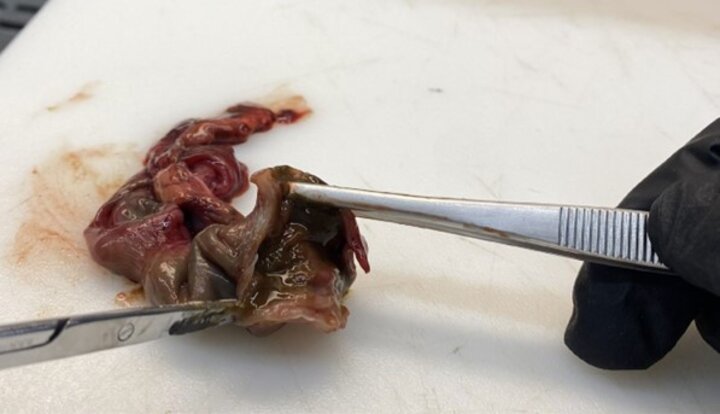By Matthew Hille, D.V.M, Ph.D.
The Bovine Submission form can be found here. Please indicate testing on form.
- If you would like them pooled, please indicate that.
- Be sure to include age of calf (enteric disease) or estimated gestational length (abortions) when submitting tissue samples. Doing so will help the coordinator prioritize testing, which will help with turnaround times and keep costs down by avoiding unnecessary tests being ordered.
For current testing fees, please check our testing catalog.
The following lists are a guide for what samples to submit for scours and abortion cases, but any abnormal appearing tissue should be submitted, in addition to those listed, to avoid missing a diagnosis.
Enteric Disease Samples to Submit
- When applicable, submitting both fresh and fixed specimens is beneficial.
- Intestine (or other GIT organ that appears to be affected grossly)
- When fixing intestinal samples, it is important to expose the mucosal surface to formalin immediately to minimize autolysis. This can be done by making a ~1 cm longitudinal cut in the tissue to create a small funnel. When submerged, swirling the tissue by grasping the “funnel” edge will force formalin into the lumen of the intestine exposing the mucosa to the fixative. See image below for an example of the incision and funnel formation.

- Feces
- Fresh feces in a sealed container such as a Whirl-Pak, conical tube, etc. Not much is needed for ancillary testing; a volume equivalent to a small handful is plenty.
Abortion Workup Samples to Submit
When applicable, submitting both fresh and fixed specimens is beneficial.
- Heart
- Lung
- Liver
- Kidney
- Spleen
- Placenta (when available)
- Stomach contents (very important for abortion cases)
- This can be obtained by inserting a larger needle into the abomasum and withdrawing contents. The fluid then can be transferred to a red-top tube (or other sterile container) for shipping.
- Brain
- Aborted fetal skulls can often be split with a sharp boning style knife. Splitting the head longitudinally results in a left and right half with cerebrum, cerebellum, and brainstem still loosely connected. A good practice is to fix one half, and submit the other half fresh.
- Ocular fluid
- Withdraw fluid during the necropsy via a needle and transfer to a red top tube or other sterile container. Do not submit the eye intact. If you do this, there’s a substantial risk the eye will become dried out and/or squished during transport making it unsuitable for nitrate testing.
Recommended Tests
Individual tests can be marked on the submission form as desired or left blank. If the “Discretion of the lab” box is checked on the submission form, the case coordinator will add any additional testing they deem indicated. If this box is not checked, only testing specifically marked by the referring DVM will be ordered.
Enteric Disease
- NVDC calf diarrhea PCR panel on feces (K99+ E.coli, Salmonella, Cryptosporidium, BCV, bovine rotavirus)
- Histopathology of grossly normal and affected intestinal samples
- Aerobic culture (included with PCR panel at no additional charge)
- Anaerobic culture, fecal floatation (+/- depending on the case history)
Abortions
- NVDC abortion panel on placenta, stomach contents, or pooled fresh tissues (BVD, IBR, Leptospira, Neospora)
- Histopathology of routine organs
- Aerobic culture (included with PCR panel at no additional charge)
- Nitrate screening, Q fever PCR, fungal PCR or culture, Ureaplasma PCR (+/- depending on the case history)
Other Recommendations
- For fixed samples, try to keep the widest part of the tissue to no larger than about 1 cm to allow for proper fixation to occur.
- Submitting normal, diseased, and the junction of normal/diseased tissue for histopathology is recommended. This is particularly important for intestine, liver, and lung.
- Samples (fresh and fixed) should be shipped in a sealed and insulated container with adequate ice packs to ensure the proper temperature is maintained during shipping. In the winter, adding 10% alcohol to the formalin will prevent freezing of the fixed tissues which can have a substantial negative impact on the utility of histologic exam of the tissue.
- A shipping label can be printed from the EZShip page of our website.
Please call the lab ( 402-472-1434) if you have any questions on submissions, supply orders, or specimens to collect for unusual cases.